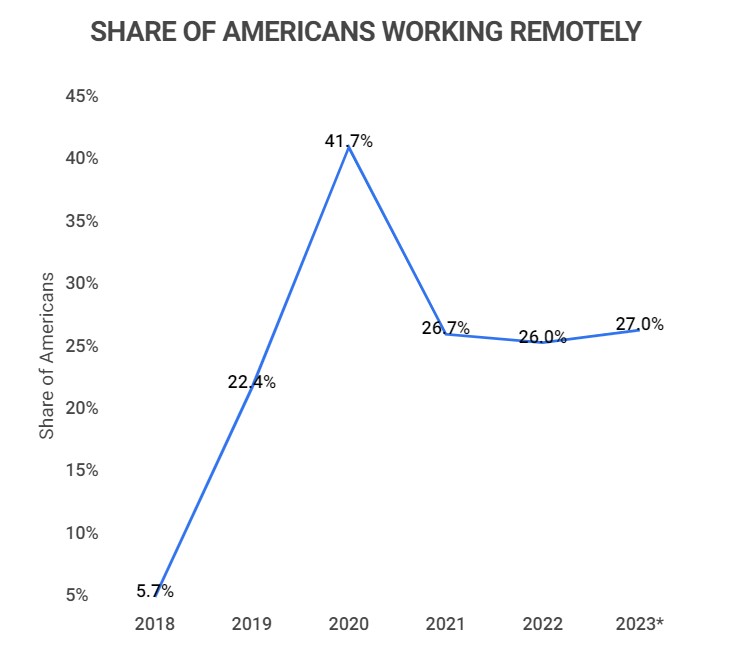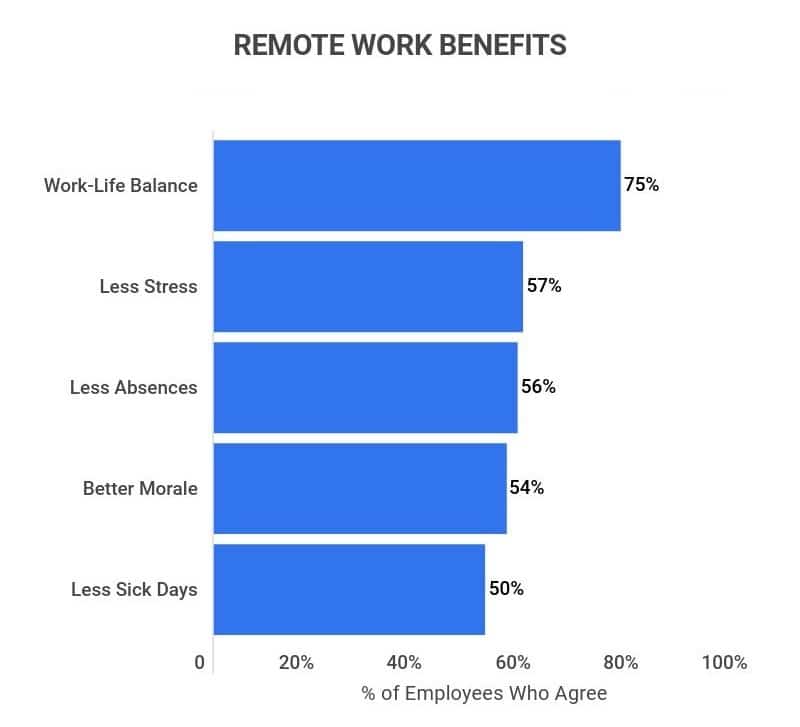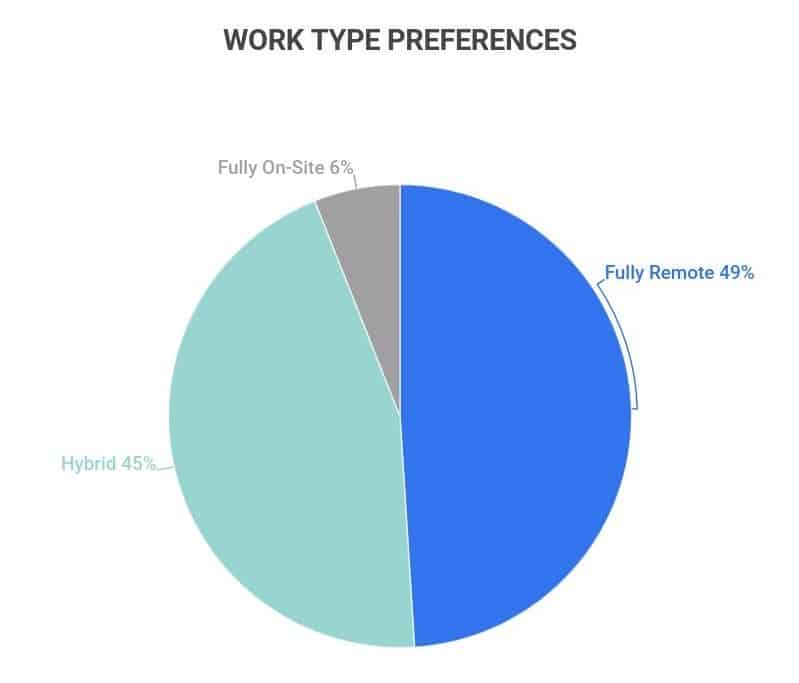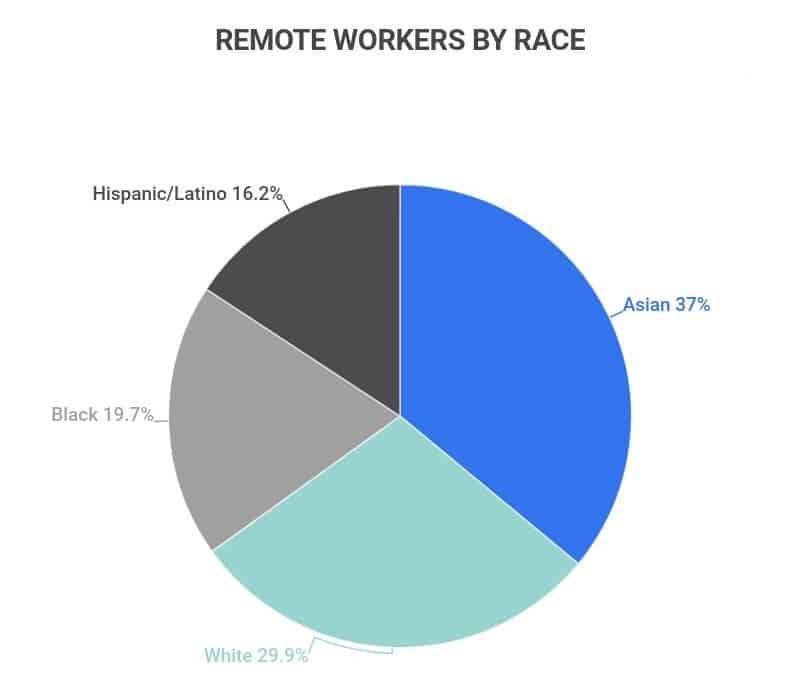Remote work research summary: Remote work increased dramatically during the pandemic, whether workers chose it voluntarily or not. And despite dropping off somewhat, the popularity and prevalence of remote work is here to stay. With that in mind, we’ve gathered all of the latest and most essential remote workforce statistics. According to our extensive research:
-
27% of U.S. employees work remotely, as of 2023.
-
There are expected to be 36.2 million American employees working remotely by 2025.
-
40% of remote workers believe that they’ve been more productive while working at home compared to the office.
-
16% of U.S. companies are fully remote.
-
Remote jobs now make up 15% of work opportunities in the US.
For further analysis, we broke down the data in the following ways:
Trends and Predictions | Benefits | Challenges | Demographics

General remote work statistics
Before we dive into more detailed remote work statistics, let’s cover the basics. Then we can start to get a picture of why Americans are making the switch to remote work. According to our research:
-
66% of U.S. employees work remotely, at least part-time.
With up to 92% of employees working at least one day per week remotely, the average U.S. worker works 5.8 remote workdays per month.
-
Currently, 68% of Americans would prefer to be fully remote.
That means a considerable majority of the U.S. workforce wants to work remotely. What’s more, at least 23% would take a 10% pay cut to work from home indefinitely.
-
At least 50% of employers believe remote work reduces absenteeism.
And the feeling is mutual among employees, as 56% say they have reduced absences, and 50% use fewer sick days. Overall, a considerable 75% say they have a better work-life balance.
-
16% of companies are fully remote.
This is still small compared to the 44% of companies that don’t allow remote work at all. However, this trend is changing over time, as 59% of workers report being more likely to choose an employer that allows remote work rather than one that doesn’t.

Remote work trends and predictions
Remote work continues to trend upwards. The pandemic served as a catalyst for greater interest among workers, as well as an impromptu experiment that tested the effectiveness of remote work. Here are some insights our research uncovered:
-
Pre-pandemic, only 6% of American workers were fully remote.
In fact, at least 75% of workers never worked remotely at all. This particularly explains why the booming interest in remote work now is such a new phenomenon.
-
From 2018 to 2021, the number of fully remote workers grew 4 times larger.
Instead of 6% of employees being fully remote, 26.7% of employees were fully remote in 2021. The highest demographics of those working from home include women and college graduates, at 35% and 38% respectively. By contrast, only 17% of those without a college degree have worked from home during the pandemic.
-
Experts predict that there will be 36.2 million Americans working remotely by 2025.
Which is a 417% increase from pre-pandemic levels, where there were only 7 million people working remotely.
-
85% of managers now believe that teams of remote workers will become the new norm.
And they may not have a choice, as 59% of workers report being more likely to choose an employer that allows remote work rather than one that doesn’t. Plus, 74% of workers agree that remote work opportunities make them less likely to leave a company.
-
81% of workers expect their employer to continue supporting remote work.
The fact is that a majority of workers are in favor of remote work, even the ones who’d never worked remotely before the pandemic.
Benefits of remote work
Remote work is popular today for many reasons. From better work-life balance to increased productivity, working from home has several benefits to offer the average worker. Here are the facts:
-
32.2% of managers agree that productivity has increased after the 2020 remote work shift.
Further, 68% of enterprises say there’s been an improvement in employee productivity since the move to remote work. Overall, a good portion of small businesses, companies, and those in positions of leadership agree that remote work has had a positive effect on productivity.
-
94% of employees report feeling like their work productivity is the same or higher than before they worked remotely.
In fact, research shows that when employees are able to work from home, their performance increases by at least 22%.
-
75% of employees believe they have a better work-life balance working remotely.
And other common benefits cited by employees include reduced stress (57%), reduced absences (56%), improved morale (54%), and fewer sick days (50%).
-
62% of workers feel remote work positively affects their work engagement.
Overall, 78% of remote work employees report feeling “highly engaged” in their work, while only 72% of in-office employees say the same.
-
21% of workers are willing to give up vacation time for flexible work options
And that’s not all, as at least 16% would give up employer-matching retirement contributions. The two of these factors combined have the potential to save employers a huge chunk of change.
-
Turnover reduces by 50% when employees have access to a remote work option.
This can largely be attributed to the other positive factors mentioned.

Challenges of remote work
Working from home isn’t all sunshine and rainbows — it does to come with a few negatives. Being out of the office brings isolation, new distractions, and overworking. Here’s what our research found:
-
40% of remote workers say that struggling to unplug at the end of the workday is their biggest challenge.
While many remote workers argue that they have a better work-life balance, a significant minority also struggle with ending their workday.
-
50% of remote workers feel lonely at least once per week.
In fact, 19% of work-from-home employees stated that “Isolation” is their #1 problem, and 70% felt left out of their workplace.
-
6% of remote workers would rather work fully on-site.
While this seems like a very small percentage, it’s worth noting that 45% would prefer a hybrid arrangement that involved time spent in the office and working remotely.

Remote worker demographics
Remote workers are more likely to work in certain industries, and these industries can also have other demographic correlations. After all, this is a new phenomenon that’s only affected certain workers. Here’s what we found:
-
37% of remote workers in the United States are Asian.
Despite only accounting for 5.4% of the U.S. population, Asians make up the largest percentage of remote workers. This is followed by White workers (29.9%), Black workers (19.7%), and Hispanic/Latino workers (16.2%).

-
Since 2020, the number of women working remotely has increased by 23%.
That’s compared to a 16% increase for men. In general, women seem to prefer remote work more than men, with 68% agreeing they’d prefer remote work post-pandemic, as opposed to 57% of men. Plus, 80% of women consider remote work a top job benefit, compared with 69% of men.
-
IT is the most common industry to adopt remote work.
This makes sense, as most IT work can be completed easily in a remote work environment. Other top industries for remote workers include Accounting and Finance, Customer Service, Healthcare, Marketing, Education, and Sales.
Remote work FAQ
-
Are remote workers more productive?
Yes, remote workers are more productive in general. In fact, workers are 13% more productive when working remotely, and overall worker productivity in the U.S. has increased by 5% since 2020.
Plus, both managers and employees agree that productivity has increased. 32.2% of managers believe productivity has increased after the 2020 remote work shift, and a massive 94% of employees report feeling like their work productivity is the same or higher than before they worked remotely.
-
What percentage of employees work remotely?
27% of U.S. employees work remotely as of 2023. Additionally, 16% of companies are fully remote. These numbers will likely increase, as 59% of workers report being more likely to choose an employer that allows remote work rather than one that doesn’t.
-
Yes, remote workers are happier according to several metrics. 75% of remote workers believe their work-life balance has improved, while 62% of workers feel remote work positively affects their work engagement.
Of course, remote work also has its drawbacks. Mainly, 50% of remote workers say they feel lonely at least once per week.
-
Do companies save money with remote employees?
Yes, companies often save money with remote employees. Between reduced commute times, fewer absences/sick leave, reduced turnover, and increased productivity, employers stand to save roughly $11,000 annually per remote employee.
Conclusion
Remote work is more common now than ever. As of 2023, 27% of U.S. employees work remotely, which is four times the number who worked remotely before 2020. By 2025, there could be as many as 36.2 million Americans working remotely.
And this type of work comes with plenty of benefits. On the whole, remote workers are less stressed (57%), have improved morale (54%), take fewer sick days (50%), and most importantly, report having a better work-life balance (75%). With all that in mind, it’s no surprise that 68% of Americans would prefer to be fully remote.
And employers realize this despite the few disadvantages that come with remote work. They also stand to save money and improve productivity. That’s why experts predict continued growth for remote work.
References
-
Cision. “66% of U.S. Employees Are Working Remotely at Least Part-Time During the COVID-19 Pandemic.” Accessed on December 30th, 2021.
-
United States Census Bureau. “2017 ACS 1-year Estimates.” Accessed on December 30th, 2021.
-
Thomas Jefferson University. “Why More Companies Are Hiring Remote Employees.” Accessed on December 30th, 2021.
-
NCCI. “Remote Work Before, During, and After the Pandemic.” Accessed on December 30th, 2021.
-
Gallup. “U.S. Remote Workdays Have Doubled During Pandemic.” Accessed on December 30th, 2021.
-
CNBC. “1 in 4 Americans will be working remotely in 2021, Upwork survey reveals.” Accessed on December 30th, 2021.
-
Clarkstaff. “Why Outsourcing and Hiring Remote Staff Will Forever Be the New Normal?” Accessed on December 30th, 2021.
-
Gartner. “Gartner HR Survey Reveals 41% of Employees Likely to Work Remotely at Least Some of the Time Post Coronavirus Pandemic.” Accessed on December 30th, 2021.
-
VentureBeat. “Remote work is boosting productivity, study finds.” Accessed on December 30th, 2021.
-
Stanford Graduate School of Business. “Does Working from Home Work? Evidence from a Chinese Experiment.” Accessed on December 30th, 2021.
-
SIA. “Remote Work Improves Employee Engagement, Say 62% of Workers.” Accessed on December 30th, 2021.
-
FlexJobs. “Top 5 Reasons Flexible Work Benefits Employers.” Accessed on December 30th, 2021.
-
wbur. “Productivity, Retention And Cost Savings: Why Working From Home Benefits Employees And Employers.” Accessed on December 30th, 2021.
-
Insight. “Remote workers struggle most to switch off from work.” Accessed on December 31st, 2021.
-
Bit.Ai Blog. “Combating Social Isolation in Remote Working.” Accessed on December 31st, 2021.
-
Gallup. “Remote Work Persisting and Trending Permanent.” Accessed on December 31st, 2021.
-
Statista. “Share of employees who could work from home in the United States in 2017-18, by ethnicity.” Accessed on December 31st, 2021.
-
Axios. “The gender divide in remote work.” Accessed on December 31st, 2021.
-
Number 8. “7 Industries Making Remote Work Commonplace.” Accessed on December 31st, 2021.






